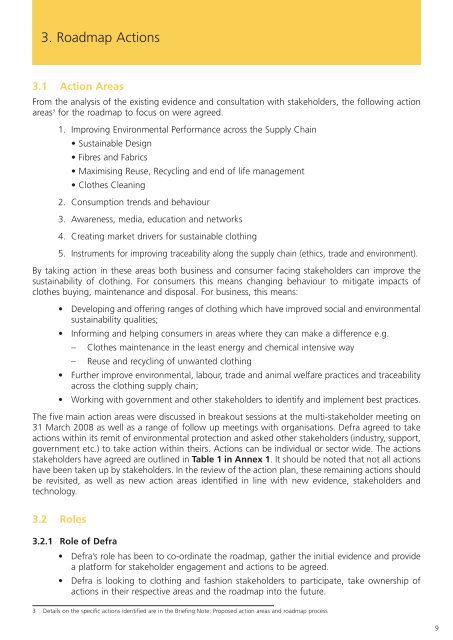SUSTAINABLE CLOTHING ACTION PLAN - Defra
SUSTAINABLE CLOTHING ACTION PLAN - Defra
SUSTAINABLE CLOTHING ACTION PLAN - Defra
You also want an ePaper? Increase the reach of your titles
YUMPU automatically turns print PDFs into web optimized ePapers that Google loves.
3. Roadmap Actions<br />
3.1 Action Areas<br />
From the analysis of the existing evidence and consultation with stakeholders, the following action<br />
areas 3 for the roadmap to focus on were agreed.<br />
1. Improving Environmental Performance across the Supply Chain<br />
• Sustainable Design<br />
• Fibres and Fabrics<br />
• Maximising Reuse, Recycling and end of life management<br />
• Clothes Cleaning<br />
2. Consumption trends and behaviour<br />
3. Awareness, media, education and networks<br />
4. Creating market drivers for sustainable clothing<br />
5. Instruments for improving traceability along the supply chain (ethics, trade and environment).<br />
By taking action in these areas both business and consumer facing stakeholders can improve the<br />
sustainability of clothing. For consumers this means changing behaviour to mitigate impacts of<br />
clothes buying, maintenance and disposal. For business, this means:<br />
• Developing and offering ranges of clothing which have improved social and environmental<br />
sustainability qualities;<br />
• Informing and helping consumers in areas where they can make a difference e.g.<br />
– Clothes maintenance in the least energy and chemical intensive way<br />
– Reuse and recycling of unwanted clothing<br />
• Further improve environmental, labour, trade and animal welfare practices and traceability<br />
across the clothing supply chain;<br />
• Working with government and other stakeholders to identify and implement best practices.<br />
The five main action areas were discussed in breakout sessions at the multi-stakeholder meeting on<br />
31 March 2008 as well as a range of follow up meetings with organisations. <strong>Defra</strong> agreed to take<br />
actions within its remit of environmental protection and asked other stakeholders (industry, support,<br />
government etc.) to take action within theirs. Actions can be individual or sector wide. The actions<br />
stakeholders have agreed are outlined in Table 1 in Annex 1. It should be noted that not all actions<br />
have been taken up by stakeholders. In the review of the action plan, these remaining actions should<br />
be revisited, as well as new action areas identified in line with new evidence, stakeholders and<br />
technology.<br />
3.2 Roles<br />
3.2.1 Role of <strong>Defra</strong><br />
• <strong>Defra</strong>’s role has been to co-ordinate the roadmap, gather the initial evidence and provide<br />
a platform for stakeholder engagement and actions to be agreed.<br />
• <strong>Defra</strong> is looking to clothing and fashion stakeholders to participate, take ownership of<br />
actions in their respective areas and the roadmap into the future.<br />
3 Details on the specific actions identified are in the Briefing Note: Proposed action areas and roadmap process<br />
9

















